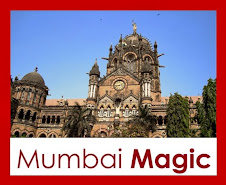- by Deepa Krishnan
After many years of being a totally boring office complex, BKC is slowly becoming a nice place to dine out. I am referring of course, to Yauatcha and Otto Infinito, both of which have added some zing to the area in the past year or so.
For me, the nicest thing about dining at these two places (they are in the same building) is that there are wide roads leading up to the restaurant. You can actually pull up at a decent-looking open driveway, see some open spaces, and feel the breeze in your hair as you walk up to the restaurant.
 |
| Path leading up to Yauatcha and Otto Infinito |
There is lots of space for parking nearby. Unlike South Mumbai's restaurants, you don't have to go through ridiculous manouevres to reverse, turn, slide and somehow squeeze the car into tiny spaces. Or worry about whether or not there is valet parking. Otto Infinito even offers open air dining minus the crazy din of car horns.
 |
| Outdoor seating at Otto Infinito |
The restaurants themselves are large, with lots of seating, and views through wall-length glass windows.
 |
| There's a yellow theme going on at Otto Infinito |
 |
| And a blue one at Yauatcha |
The food at Yauatcha is tasty and attractively presented, but I cannot figure out why the portions are stingy (our fried rice was a small portion stuck at the bottom of a mostly empty bowl). There were 3 of us, and after 3 soups, 3 starters, the main course and lots of tea, we were still feeling like hungry little Hobbits.
 |
| Main course - rice, noodles, chicken. |
Maybe it was because the food didn't flow smoothly to the table in a nicely orchestrated sequence. The service was outstandingly bad, with long periods of being ignored by waiters, orders written wrongly, and multiple waiters totally clueless about what was happening at our table. In fact, it was so amateur that I wondered if some rookie training session was going on. But even with the snafus, Yauatcha is a nice place to catch up with friends for Sunday brunch. There are big tables where a large group can be comfortably seated, the food tastes good, and there's a casual buzz. You can do some people-watching as well!
With Otto Infinito, we had some hits and misses with the food. Some stuff was very good, and some was mediocre, but the service was superlative and made up for everything. The outdoor tables are really attractive, and right now in Mumbai's short-lived winter, I'd say it makes for a perfect evening out with wine and a Mediterranean salad.
Apart from these two stand-alone restaurants, BKC has some other casual dining options as well:
 |
| California Pizza Kitchen, BKC |
 |
| Le Pain Quotidien, BKC |
California Pizza Kitchen, Pizza Hut, Le Pain Quotidien - and maybe a couple of more places that I don't know - offer casually trendy places to catch up with friends. Of these LPQ is more boutique, if cafes can be called boutique! There are also expensive restaurants at the Trident and the Sofitel. The only inexpensive thing I have seen so far in BKC is a "canteen" at the Family Court. I'm hoping more places will open up soon, making BKC a great dining option in the city.





































_W_IMG_0528.jpg)








